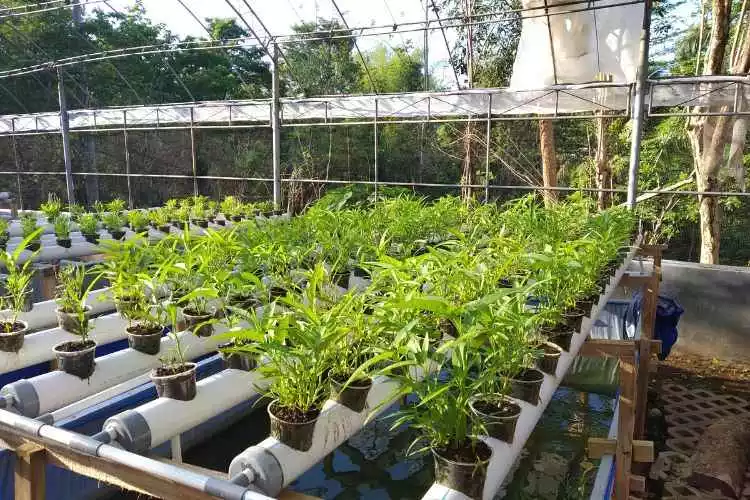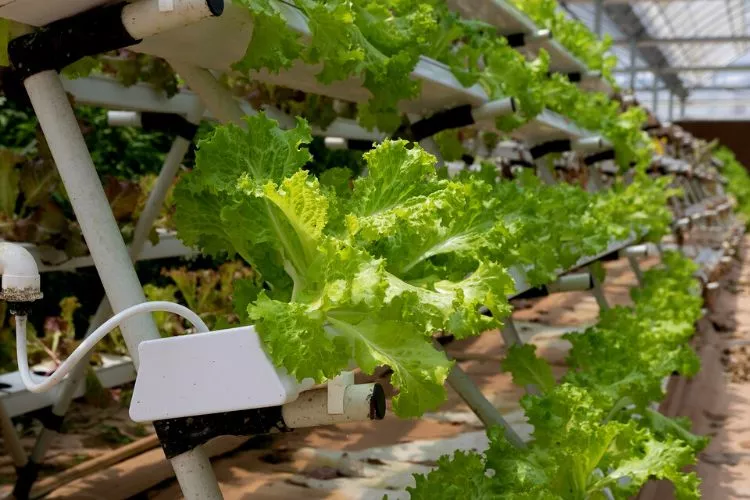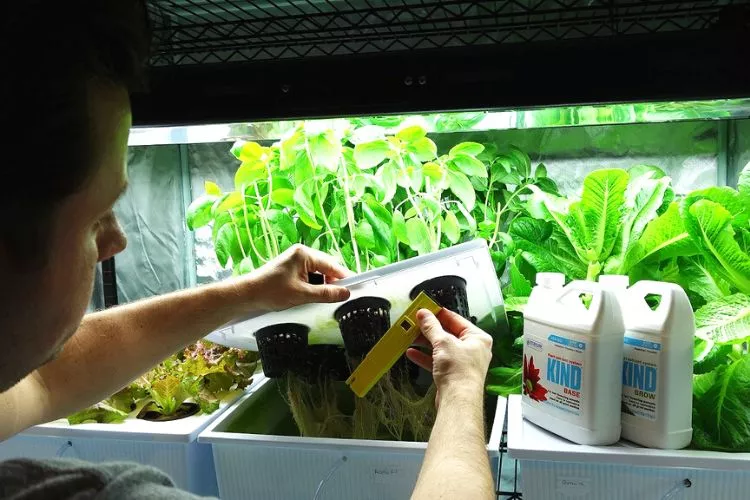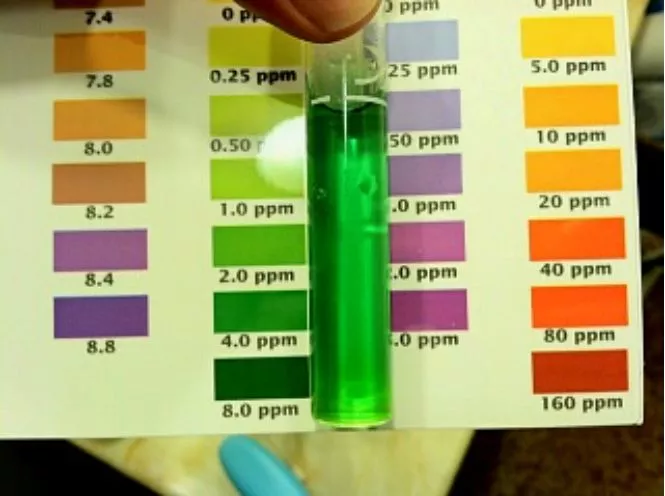Understanding the PPM chart for hydroponics is one of the most important aspects to master.
The term PPM (Parts Per Million) is an acronym that describes the measurable amount of TDS (Total Dissolved Solids) within a nutrient solution.

When the PPM of a system’s runoff is too low, more nutrients must be added to improve the balance. A PPM that is too high can mean that your plants are being overfed with nutrients which can toxify the water and kill the plants. PPM charts are one of the best tools that you can have and study.
They will ultimately guide you through the process and help to avoid damaging your plants. In this article, we’ll go through how to read and understand PPM chart for hydroponics and adjust your measurements accordingly.
Table of Contents
PPM chart for hydroponics
When we grow plants hydroponically, we’re essentially growing them in a closed, controlled system. This system has many moving parts that must be constantly monitored to ensure that the plants get everything they need when they need it to allow them to produce at an optimal level.
PPM is one of those moving parts that almost control how the rest of the system functions. Hydroponics uses water to grow plants instead of the traditional soil method.
Water and its nutrients can fluctuate much easier and faster than soil. Therefore it needs to be closely monitored.
So understanding what PPM is and how it works should be of top priority when entering the world of hydroponics. PPM (Parts Per Million) is the measured amount of TDS (Total Dissolved Solids) that are available in a solution (nutrient water). It is measured by using tools such as a TDS meter.
If the PPM drops too low, the plants aren’t receiving enough nutrients and can slowly decline in health and die as an eventual result. When the PPM is too high, the solution water can become toxic and kill the plants quickly. So, mastering PPM is one of the most important things you can do when growing hydroponically.
Let’s have a look at some popular vegetables and their optimal PPM ranges:
| Vegetable | Season | PPM |
| Artichoke | Spring | 560-1260 |
| Beans (common) | Spring | 1400-2800 |
| Beetroot | Spring | 1260-3500 |
| Lettuce | Summer | 560-840 |
| Okra | Summer | 1400-1680 |
| Radish | Summer | 840-1540 |
| Carrots | Fall/Autumn | 1120-1400 |
| Cauliflower | Fall/Autumn | 1050-1400 |
| Celery | Fall/Autumn | 1260-1680 |
| Asparagus | Winter | 980-1260 |
| Spinach | Winter | 1260-1610 |
| Turnip | Winter | 1260-1680 |
Here are some of the most common herbs and their optimal PPM ranges:
| Herb | PPM |
| Basil | 700-1120 |
| Chives | 1260-1540 |
| Parsely | 560-1260 |
| Rosemary | 700-1120 |
| Sage | 700-1120 |
| Thyme | 560-1120 |
How To Read Or Calculate PPM Levels?
In simple terms, PPM is the amount of one specific substance (organic or inorganic) present when mixed and potentially dissolved into a larger volume of a different substance.
In our case, we look at the number of TDS (Total Dissolved Solids), a.k.a. nutrients, in the hydroponic water solution. When it comes to reading or calculating this measurement, a few other metrics help us get there.

pH (Potential Hydrogen)
The pH scale specifies if the measured substance is acidic or basic (alkaline). It ranges from 0-14. 0-7 being acidic, 7 being neutral, and 7-14 is basic (alkaline).
So the pH tells us about the balance of the available nutrients about the number of nutrients that exists (PPM) within the solution.
EC (Electrical Conductivity)
It is a measurement that can reveal the quality of the available nutrients. It can be presented in milliSiemens per linear centimeter (mS/cm) or micro siemens per linear centimeter (mS/cm) where 1mS = 1000µS.
How to read and calculate PPM?
So now that we understand how these specific measurements relate to PPM, we can start to read and calculate them. The simplest method of taking a reading is by using a truncheon meter. Then do the following:
- Hold the truncheon probe tip in the nutrient solution for at least 2 minutes. Make sure that the whole tip is completely submerged.
- Then simply take that measurement and refer it to a PPM chart.
- Once you have a reading, adjust the solution accordingly.
- Add clean, fresh water or a carbon filter to lower the PPM to regulate the solution.
- To raise the PPM, add more nutrients but stick to a strict nutrition plan; otherwise, the plants can suffer from toxic shock.
- Rinse the meter with clean water once the testing is complete.
How To Adjust PPM Level In Hydroponics?
It’s all well and good to measure reading, but what do you do with those figures? If the PPM reading is too high, the solution has too many nutrients.
Too many nutrients overfeed the plants, causing the water to become toxic and ultimately kill them. You will need to lower the PPM as soon as possible.
This problem can be corrected by doing a few things. As a quick fix, you can add fresh, clean water into the reservoir to dilute the nutrients. This may require draining out some of the water if there isn’t enough space to top the water up.

Alternatively, if the reading isn’t dangerously high, you can wait for the growing cycle to finish and completely flush out the water. Then fill the reservoir with fresh, clean water.
Another option is to install a carbon filter to help remove any impurities and distribute the nutrients a little more evenly.
In contrast, when the PPM is lower than what it should be for those specific plants, they are not receiving enough food. As a result, they will become undernourished, which won’t allow them to grow properly.
The simple fix here is to add some more nutrients to the reservoir. It’s always best to add slightly less than required and take another reading to slowly get to the appropriate level. This will help to avoid toxifying the water unnecessarily.
What ppm scale do I use for General Hydroponics?
PPM scales are one of the most important measurement tools in the hydroponics industry. The 2 most common scale types are the PPM 500 and the PPM 700. There is no one size fits all regarding the 2 types. Using the scale your nutrient provider uses when manufacturing their products is best.
For example, the Bluelab brand of meters or pens takes multiple readings, including EC as well as both PPM 500 and PPM 700 scales.
Whereas the brand Botanicare only uses the PPM 700 scale. So for Bluelab, you could take your pick with scale usage, whereas with Botanicare, you could only use the PPM 700 version.
How much PPM is too much?
Balancing a hydroponic system’s PPM can be challenging when first starting. However, understanding how to tweak the figures to ensure only minor adjustments are made is one of the most useful skills to master over time.
What happens if the PPM increases by too much, though? Is there a limit that plants can handle? It’s best to keep the PPM at the exact level for your growing plants.

However, keeping them between 800 to 1500 won’t do too much damage to the plants if left in that range for short periods. Anything over 2000 for most plants can be harmful.
Vegetables such as beans (1400-2800) and beetroot (1260-3500) can handle a little more. It’s always best to research the specific plant type that is grown and try to keep within the range as much as possible to optimize growth and yield.
Frequently Asked Questions (FAQs)
What is the PPM for lettuce?
The optimal PPM for growing lettuce hydroponically is between 560-840
What PPM should strawberries be?
Strawberries need different PPM depending on their growth stages. It’s recommended to keep the PPM between 800-900 at the start, then decrease it to 400-500 PPM during the blooming/fruiting stage.
What should my PPM be during veg?
It all depends on the type of plant you are trying to grow. As a general guide, you can go with Early Vegging: 650 – 750 PPM (transplant), Mid-Stage Veg: 750 – 800 PPM, and then Late-Stage Veg: 850 – 900 PPM.
What should my co2 PPM be at veg?
Co2 is more important during the flowering phase to assist with flowering and fruiting. However, using around 800 PPM without exceeding that amount is optimal during veg. Keeping CO2 levels around 1200-1500 PPM is much more beneficial for flowering/fruiting.
How do I know if my EC is too high?
You will first notice some visual signs, such as leaf discoloration, which can include interveinal chlorosis. You may also see thickened or necrotic looking roots and brown spotting of necrosis all over the leaves. They may even present other characteristic changes, such as stunted size or a reduction in leaf productivity.
What causes a high PPM?
Excess nutrients/fertilizer in the solution. Topping off the reservoir when the water evaporates can also cause the PPM to rise. It’s always best to measure the PPM before and after adjustments to ensure that fluctuations don’t occur.
Do nutrients raise ppm?
Yes, adding nutrients will raise the PPM. However, adding them in the correct amounts will ensure optimal balance. This will enable the PPM to be increased to the optimal level without contaminating the water.
Conclusion:
Understanding PPM and its associated charts is an extremely important aspect of growing plants in a hydroponics system.
It can be daunting initially, but once you get the hang of it, it’s like riding a bike! As long as you have a decent quality TDS reader and plant chart, then you shouldn’t have any worries at all.
We hope this article on the PPM chart for hydroponics has been helpful, and we look forward to seeing you next. Happy growing!


